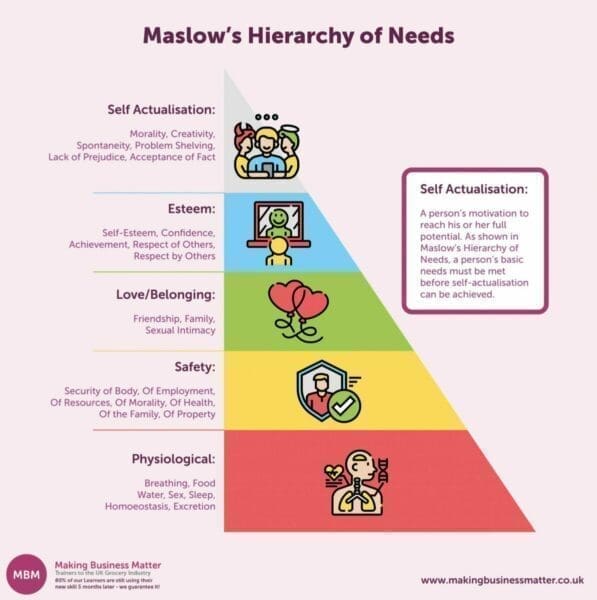It’s Enough to Make you Jack it in
Herzberg’s motivators are a set of insights American psychologist Frederick Herzberg described in his 1959 book ‘The Motivation to Work.’ Mr Herzberg’s motivators help us appreciate why people change jobs. They have fresh importance now, with employees wondering, do I really want to return to the office?
Herzberg proposed we have two sets of needs. Herzberg’s Motivators concern our higher human nature and our drive to grow psychologically. But the others, the hygiene factors, are animal. They involve the evolved mammal part of our nature, seeking to avoid discomfort. The two interact powerfully in workplace behaviour. And if we aren’t motivated and purposeful, the negative energy this creates can affect our mental health. Hopefully, this article will help you empathise with your colleagues before that happens.
Don’t Let This Place Get to You!
What is Herzberg’s 2 Factor Theory?
Herzberg’s 2-factor theory is this stuff we’re talking about, the Herzberg Motivators and the Hygiene factors. Certain workplace factors cause job satisfaction. The motivators encourage employees to work harder and include:
- Achievement.
- Recognition.
- Rewarding work.
- Increased responsibility.
- Personal advancement.
- Growth opportunities.
Herzberg also identified another, separate set of factors with the opposite effect, causing dissatisfaction. These are the hygiene factors. They won’t encourage us to work any harder. But they can be demotivating if they aren’t present.
Some of the hygiene factors could be surprising. Especially to managers and leaders who insist employees should be grateful for a job.
Herzberg’s hygiene factors are:
- Company policies.
- Supervision.
- Work relationships.
- Work conditions.
- Remuneration.
- Salary.
- Security.
It would be interesting in this context to know how employees view such things as flexible working and workplace wellbeing support. Are they motivators or hygiene factors? As research emerges, it will become clearer.
How Does Herzberg’s Theory Apply to the Workplace?
As we’ve established, Herzberg saw employee satisfaction as having two clear dimensions, hygiene and motivation. Hygiene issues such as salary and supervision decrease employees’ dissatisfaction with the work environment. By contrast, motivators like recognition and achievement have a positive effect. They make workers more productive, creative and committed.

Sticky Learning ® is 7 times more effective than 1-day training courses. Plus, you will get a Chain of Evidence proving your Return on Investment. Discover soft skills training that changes behaviours long term.

What’s an Example of the Two-Factor Theory in Action?
The two-factor theory focuses on improving employee satisfaction. You can leverage the theory to get the best from your team. But beware, it’s subject to bias. When employees are satisfied, they tend to give themselves the credit. However, dissatisfied individuals blame external factors and work less hard. You read it here…
Why is Herzberg Important?
Herzberg’s motivators and theories recognises the intrinsic satisfaction that employees can obtain from the work itself. Here again, managers need to be alert. Employees’ motivation problems may not necessarily be directly task related. And problems can often be external to the job.
So What is the Difference Between Hygiene and Motivation Factors?
Hygiene factors are related to the job and are essential workplace requirements. In contrast, motivational factors positively motivate employees to improve their performance.
I’ve Got Every Reason on Earth For Doing This
Herzberg’s theory isn’t the only thinking regarding how workplace factors affect motivation. He based his work on Abraham Maslow’s hierarchy. This describes how we address basic needs but also strive for fulfilment. Another writer, Ralph Stogdill placed great importance in the ‘consideration’ (supportive) aspects of leadership, namely respect and trust.

You can value these workplace impacts in pounds and pence. Management and leadership’s behaviour significantly affects the business’s bottom line directly. Daniel Goleman’s leadership styles work bears this out.
What Different Theories of Motivation are There?
Leaders and managers should also familiarise themselves with Maslow’s ideas about fulfilment and purpose’s contribution to job satisfaction. People also use the term self-actualisation.
Two other need-based motivation theories managers and leaders might find helpful are:
- Alderfer’s ‘ERG’ theory.
- McClelland’s acquired needs theory.
Let’s look at these:
Clayton Alderfer’s ERG Theory
This was devised in 1969, modifies Maslow’s hierarchy. Instead of the strict hierarchy, Maslow insists on, Alderfer argues there’s no particular sequence. He suggests people who aren’t satisfied in one need, compensate in other ways. Hence someone frustrated at work and not self-actualising may take to socialising with colleagues.
McClelland’s Acquired Needs Theory
The last of these is McClelland’s Acquired Needs theory. David McClelland refined some of Maslow’s higher-order needs, making them more relevant to people in organisations. In McClelland’s theory, individuals acquire three types of need through life experiences. These needs are achievement, acceptance and power.
Herzberg, Maslow, Alderfer and McClelland’s ideas are called content theories. They explain what motivation is. We’re now going to look at some ideas about how this occurs and how our motives can change over time. These are called process theories.
Reinforcement theory is probably the best known process theory. This focuses on how the likely consequences of our behaviour motivate us. Positive reinforcements are promoters that increase our likelihood of repeating particular behaviour. They are different from negative reinforcements. There you get only what you need in return for a desired behaviour. And they’re different from punishments, which stop undesired behaviour by inflicting unpleasant consequences.
Adam’s Equity Theory
Adams’ equity theory states we’re motivated when we’re treated fairly and receive what we consider fair for our efforts. The ‘Equity’ theory considers how we don’t just measure our pay against our performance, but we compare it with what others receive.
Victor Vroom’s Expectancy Theory
Victor Vroom’s expectancy theory (1964) combines the needs, equity and reinforcement theories to explain how we make choices. Vroom suggests three things motivate us to action:
- Expectancy – belief that more effort will produce more success.
- Instrumentality – seeing the connection between our activity and the goal.
- Valence – knowing how important the possible reward or success is to us.
Locke’s Goal Setting Theory

Our last theory came to prominence relatively recently, in 1990. Locke’s goal setting theory sees goals as key determinants of work behaviour. His theory covers:
- Setting challenging but attainable goals. Don’t make them too easy, or difficult!
- Making goals specific and measurable. This will focus us and help us track our progress.
- Committing to the goals. If we don’t, we won’t put in the effort, however easy they are.
You can increase people’s commitment to goals by including them in goal setting. And you can give your team bonuses and feedback on progress. Putting pressure to achieve goals isn’t helpful, because it can promote dishonesty and shortcuts. But encouragement, necessary resources and moral support make all the difference. Keeping people updated about their results is essential. So make goals clearly measurable, and as we said, support your team with proper feedback.
Please Sir, Can I Have Some More Motivational Theories?
People have come up with many theories about employee motivation. Some of these highlight feedback, and others emphasise autonomy and wellbeing.
If you find your work more satisfying when your performance is monitored, you’re not unusual. Elton Mayo developed an explanation of this. He called it the Hawthorne Effect. This suggests employees are more productive when they know their work’s being measured. Mayo recognised workers need appreciation for a job well done and reassurance that their opinion matters in the workplace.
Douglas McGregor came up with two theories, Theory X and Theory Y, about employee motivation and its implications for management. McGregor envisioned two kinds of employees. The Theory X employees avoid work and dislike responsibility. Theory Y employees make more effort when they have control. By contrast, Theory X employees respond to rules and punishments. To motivate Theory Y employees, management must develop opportunities to take responsibility and show creativity.
In response, Dr William Ouchi developed a third theory, Theory Z. This focuses on increasing employee loyalty by providing a job for life and focusing on the employee’s wellbeing. Theory Z motivates employees in the workplace by encouraging group work and social interaction.
You’re Entitled to Your Opinion
Mr Herzberg went on to become one of the most influential names in business management. His 1968 publication ‘One more time, how do you motivate employees,’ sold 1.2 million reprints by 1987. But Herzberg’s Two Factor theory isn’t without its critics. First of all, some people say there isn’t that much difference between the factors leading to satisfaction and dissatisfaction. Let’s see the lists again:

Herzberg’s motivators include:
- Achievement
- Recognition
- The work’s nature
- Responsibility
- Advancement
- Opportunities for growth
And the hygiene factors are:
- Company policies
- Supervision
- Work relationships
- Work conditions
- Remuneration
- Salary
- Security
As we said earlier, our individual perceptions about work satisfaction are prone to bias. When employees are dissatisfied, they tend to blame external factors and work less hard. But when they’re satisfied, they’re likely to give themselves credit for that satisfaction. Hence, an employee who’s paid well and has control and responsibility will probably be motivated.
Also, the theory doesn’t allow for an individual’s particular perception or their situation. To address this, try applying the theory on an individual basis. Also, there’s no way of applying metrics and measuring employee satisfaction objectively.
Lastly, the critics say Herzberg’s motivators is one of those theories that make apparent sense, so it’s widely accepted. But it hasn’t received strong research support. Specifically, Rynes, Gerhart and Parks (2005) have criticised the theory because of the methods used to develop the two factors. Rynes and colleagues highlight that factors such as pay can be both hygiene factors and when included under recognition, a motivator. They also point to the fact that few independent research studies have come up with the same results.
How to Use Herzberg’s Motivators Theory to Boost Productivity

But the critics are choosing to overlook one very important point. Namely, this theory does stand up.
There are various ways you can craft your company policy to incorporate Herzberg’s principles. From there you can implement new policies that increase both ‘hygiene’ and ‘motivation’ in the workplace. Some of these ideas include:
Give employees more autonomy: the more people feel they are responsible and autonomous, the greater sense of achievement they will feel. Autonomy is a powerful motivator. The more an employer can encourage employees to take ownership of their work, the happier they feel doing it.
Provide feedback: Let people know how well they’re doing. And let them know how they can do better. That’s also important in increasing motivation.
Enhance working conditions: Hygiene really is a source of dissatisfaction. Literally! You can instantly improve the work hygiene factors by providing a clean, pleasant environment. Safety is important but sometimes employers skimp on the design. Keep your premises well lit, and remember to pay attention to hygiene.
Ask your employees: A poll offers a good way to find out what motivates employees. Checking in with your team will highlight areas for improvement and show which ones they see as more important. But that doesn’t mean you should neglect the other areas they don’t mention!
Take a 360 degree view of employee welfare: Herzberg’s two-factor theory maintains that employers should not choose to focus on either motivation or hygiene. Instead, they should work to deliver on both. Bosses can shape company policy to improve employee welfare. That way they can avoid low motivation and low hygiene simultaneously. Employee satisfaction means paying attention to a range of needs in both areas.
Do Any Famous Companies Work With Herzberg’s Theory?
Yes, Tesco uses Herzberg’s theory to motivate its employees. Britain’s biggest supermarket business pays attention to factors causing dissatisfaction, as well as those causing satisfaction. For example, they involve employees in decision making and delegate wherever possible. Tesco also hold forums every year in which staff can provide input on pay rises.

Google also uses the two factor theory. They make their leadership well aware of the fact they must provide hygiene factors to avoid employee dissatisfaction but also provide intrinsic motivators to the work itself. But Apple uses Victor Vroom’s expectancy theory. Remember that and you’ll win in your next Zoom work team quiz!
AND FINALLY – Where Can Herzberg Lead us?
The US healthcare industry uses Herzberg’s theory in their staff motivation. Consequently, this points to how areas like marketing and advertising could use it in future. In healthcare, increasing job satisfaction for a highly skilled workforce rests on finding a balance between professional and occupational priorities. Therefore, Herzberg helps make managers aware of the contribution of job challenge and responsibility in employee motivation. US healthcare also uses Herzberg’s theory to address staff motivation in hospital pharmacies and turnover among psychiatric nurses.

Here are some take out tips to consider, based on what works with engineers:
How to Improve the Dissatisfying Factors in Your Business:
- Offer competitive salaries.
- Provide safe, comfortable working conditions where employees can focus on doing great work.
- Create teambuilding activities to help employees and managers get to know one another and work together better.
- Be flexible with workplace policies and rules when appropriate. Allow ‘WFH’ days or flexi hours if employees need them.
How to Improve the Motivating Factors:
- Provide interesting and challenging work to keep employees, busy, interested and using their skills.
- Recognise hard work and achievements.
- Give people more responsibility within the company.
- Offer clear paths to advance careers without having to leave and go elsewhere.
- Give employees opportunities for personal growth through training.
Here’s a parting thought. The accepted reason employees see salary as a hygiene factor is because most people have a salary floor. Early on it’s a motivator. But once they reach a comfortable level, pay becomes less of an issue. Understanding Herzberg’s Motivators is important in thinking about how to handle employees. Therefore, motivators are important in helping find and keep the best people. But ultimately you keep good people by empowering them to do their best work in the best environment. Focus on that and you’ll reap the rewards.




